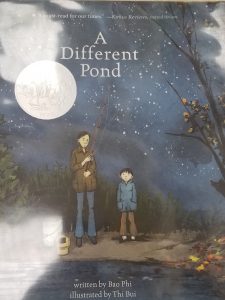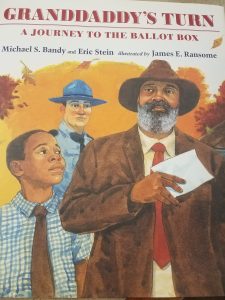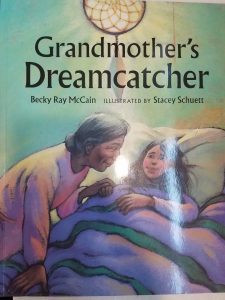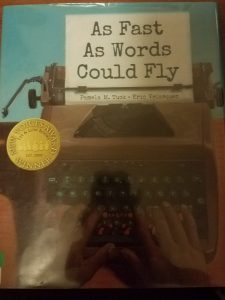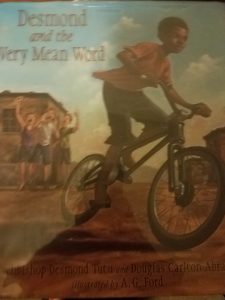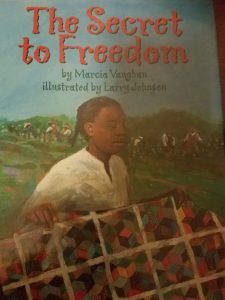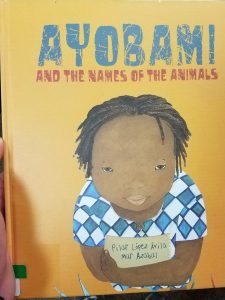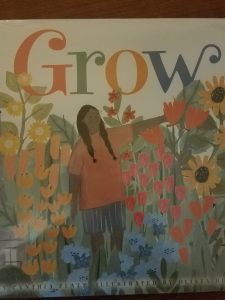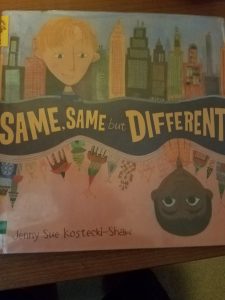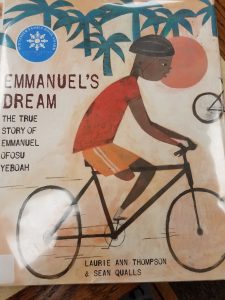
Title: Emmanuel’s Dream
Author: Laurie Ann Thompson
Illustrator: Sean Qualls
Publisher and Year: 2015 Schwartz & Wade
Number of pages: 40
Tags/Themes: Award Book, Culture, Diversity, Non-fiction, 2-3, 4-5, Evan White
Genre: Africa, Biography, Non-Fiction, Children’s, Cultural, Picture
Descriptive Annotation: Emmanuel’s Dream is about a young boy, Emmanuel, who was born with one good leg in Ghana, West Africa. His father left the family, but his mother supported him. Emmanuel would shine shoes for money and bought a soccer ball to play with the school children. Through this, the school kids respected Emmanuel playing soccer with one leg. When he became older, Emmanuel went to the city of Accra to work for money. In the city, he would get discriminated against for having a disability. He decided he would buy a bike, ride it across and share a message of how people with disabilities can achieve great things. He rode his bike over 400 miles and became a national image. Film crews followed him to share his message.
Classroom Application: This text reinforces geography and culture. The book shows how the boy lives in West Africa, an area the students probably won’t know much about. The story demonstrates Social and Emotional Learning Standards by demonstrating skills related to achieving personal and academic goals. Emmanuel didn’t let society tell him what he could and couldn’t do. He created a personal goal of showing his country people with disabilities are strong, and he accomplished it using his skills and using external resources, like getting a film crew and a bike. This stretches the students mind by showing them they can be strong by destroying harmful norms in their society in ways that are small and unique to the individual student.
Linguistic and Cultural Diversity Analysis: This book shows the society of Ghana. It can foster inquiry of how students from across the globe have strong goals and can achieve them, even when their society is trying to dictate how they should act. “Shopkeepers and restaurant owners told him to go out and beg like other disabled people did. Emanuel refused. Finally, a food stand owner offered him a job and a place to live” (17). With a little support, he was able to achieve his goal. “The farther Emmanuel rode, the more attention he got. Children cheered. Able-bodied adults ran or rode along with him. People with disabilities left their homes and came outside, some for the very first time. The young man once thought of as a cursed was becoming a national hero” (30). Emmanuel was changing the norms and culture in Ghana for how to view people with disabilities, and was met with enthusiasm for his actions. In Ghana, the book shows the citizens view people with disabilities harshly, telling them to beg, or even abandoning them. Emmanuel was changing that culture climate. I might introduce this book by showing the students what Ghana is like, showing the students the landscape, grasslands, narrow highways, and the rain forest. I think seeing the landscape will have the students think the bike riding is more impressive than the book depicts . The book mostly shows Emmanuel talking to people, but I also want to the students to see how tough riding a bike would be to appreciate the work while reading or listening.

